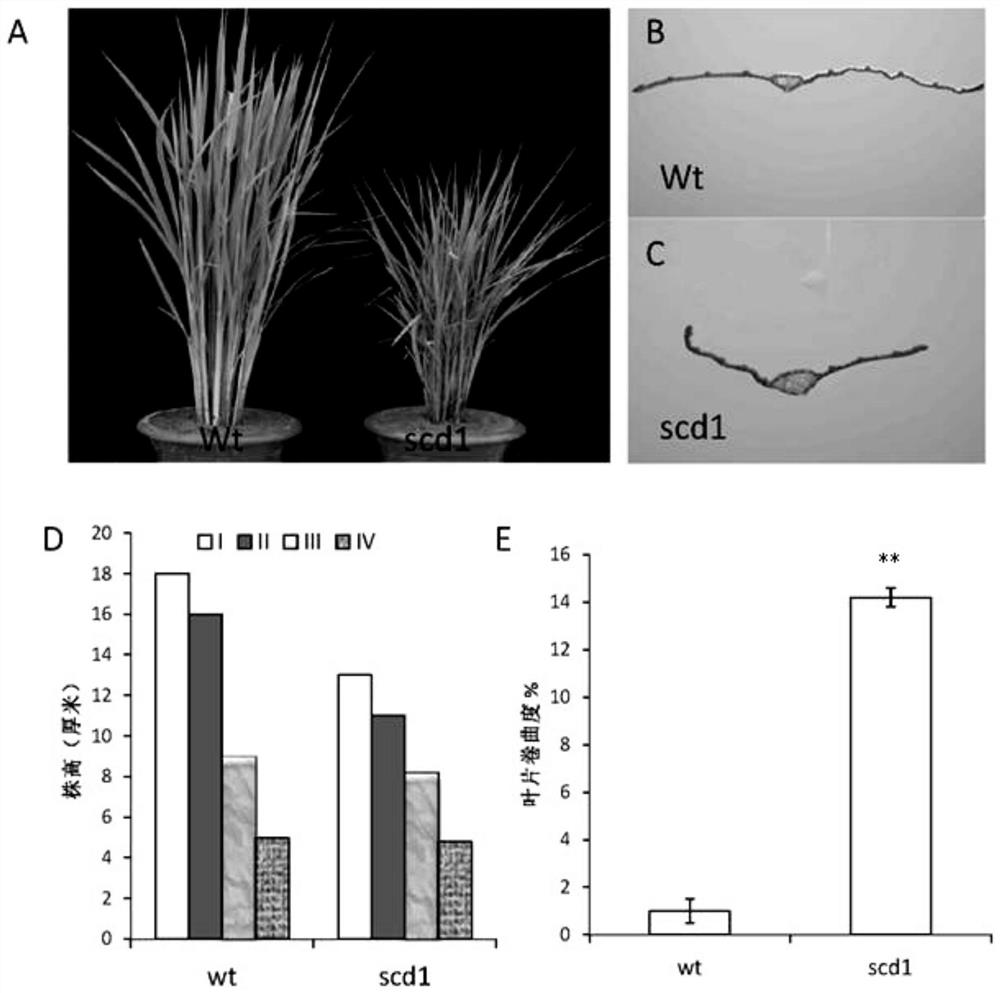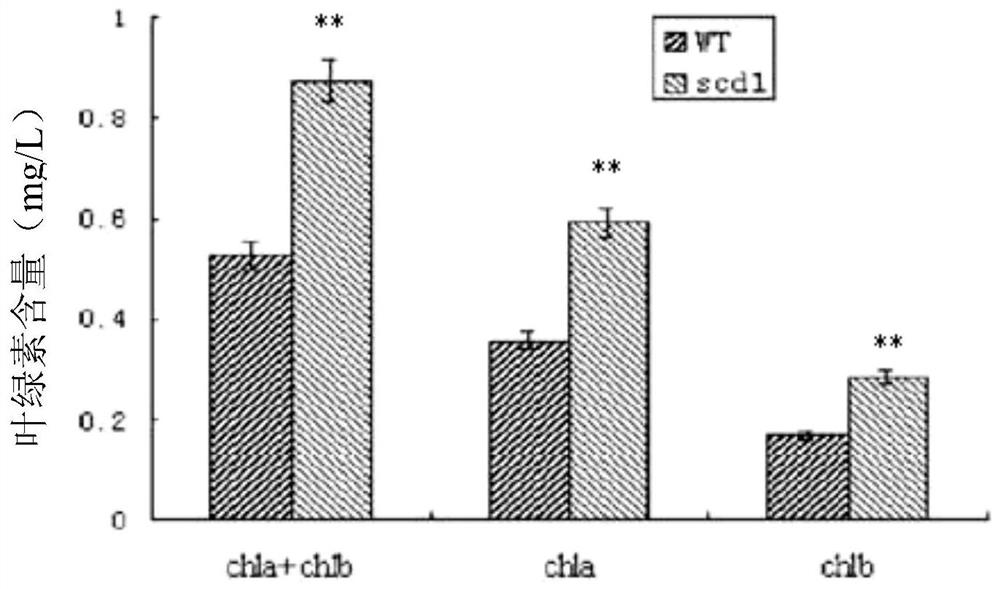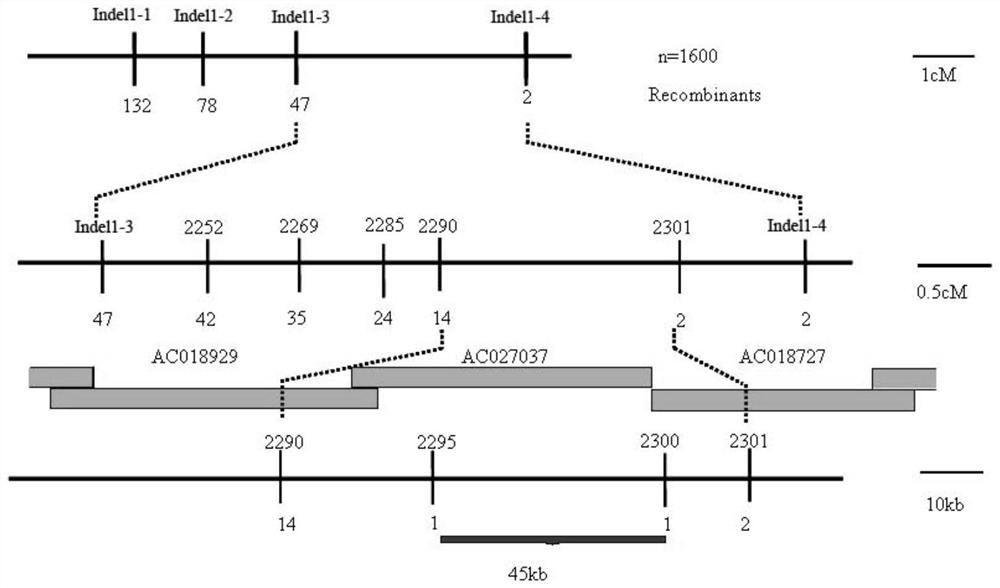Application of rice PHI1 gene in regulation and control of plant photosynthesis
A photosynthesis, plant technology, applied in the field of plant genetic engineering, can solve problems such as little known
- Summary
- Abstract
- Description
- Claims
- Application Information
AI Technical Summary
Problems solved by technology
Method used
Image
Examples
Embodiment 1
[0082] Example 1, the acquisition of PHI1 protein and its coding gene
[0083] 1. Phenotypic analysis of mutant scd1
[0084] The plant height and leaf curl degree of mutant scd1 and wild-type rice Nipponbare were measured, and the chlorophyll A content, chlorophyll B content and photosynthetic rate were detected at the same time.
[0085] Determination of plant height: measured at maturity, the height from the ground surface to the top of the highest ear (excluding awn) of a single plant. The data of each section is also deduced in the same way (sections are counted from top to bottom).
[0086] Curling degree (Leaf rolling index LRI) = Determination of maturity period, [Lw (leaf edge spacing after deployment)-Ln (measured at the same point the natural distance from the leaf to the leaf edge)] / Lw (leaf edge spacing after deployment) × 100 %.
[0087] Determination of photosynthetic rate: One week after the initial ear, select a sunny day with air temperature (daily average...
Embodiment 2
[0106] Example 2, construction of transgene complementary expression plants and detection of their traits
[0107] 1. Construction of pCambia23A-PHI1 recombinant expression vector
[0108] Utilize TWI1-F and TWI1-R to amplify SEQ ID No.3 (derived from rice cDNA), the obtained product is digested with SmaI / XbaI, and then used with pCambia23A vector (Beijing Dingguochangsheng Biotechnology Co., Ltd.) The recombinant expression vector pCambia23A-PHI1 was obtained by digestion with XbaI and SmaI enzymes, and was verified to be correct by sequencing.
[0109] TWI1-F-5'SmaI:5'-TT CCCGGG GTGTAAATAGTAGGCTTGTTGGAG-3';
[0110] TWI1-R-3'XbaI:5'-CC TCTAGA AAGCTTCTCTCCACTAGTCAAGTC-3'.
[0111] 2. The pCambia23A-PHI1 recombinant expression vector obtained in step 1 was introduced into Agrobacterium AGL1 (Beijing Dingguo Changsheng Biotechnology Co., Ltd.) to obtain recombinant Agrobacterium.
[0112] 3. Introduce the recombinant Agrobacterium obtained in step 2 into the transformati...
Embodiment 3
[0122] Example 3, Establishment and Phenotype Observation of PHI1 Functional Loss Transgenic Plants
[0123] 1. Interfering with plant construction
[0124] 1. Using the cDNA of wild-type rice Nipponbare as a template, PCR amplification is performed with primers P5utrF and primers P5utrR to obtain PCR amplification products.
[0125] P5utrF: 5'-GG GGTACCACTAGT GCTTTACCTAAGCGAATTCT-3';
[0126] P5utrR: 5'-CG GGATCCGAGCTC ATACATTATTACCATTTCC-3'.
[0127] In the primer P5utrF, the underline marks KpnI and SpeI restriction sites;
[0128] In the primer P5utrR, the underline marks are the restriction sites of BamH I and Sac I.
[0129] 2. Ligate the PCR amplification product obtained in step 1 with the pEasy vector (Beijing Dingguo Changsheng Biotechnology Co., Ltd.) to obtain the ligation product pEasy-PHI1.
[0130] 3. The ligation product pEasy-PHI1 in step 2 was double-digested with SpeI and SacI restriction endonucleases, and the digested product of about 0.3 Kbp was r...
PUM
 Login to View More
Login to View More Abstract
Description
Claims
Application Information
 Login to View More
Login to View More - R&D Engineer
- R&D Manager
- IP Professional
- Industry Leading Data Capabilities
- Powerful AI technology
- Patent DNA Extraction
Browse by: Latest US Patents, China's latest patents, Technical Efficacy Thesaurus, Application Domain, Technology Topic, Popular Technical Reports.
© 2024 PatSnap. All rights reserved.Legal|Privacy policy|Modern Slavery Act Transparency Statement|Sitemap|About US| Contact US: help@patsnap.com










